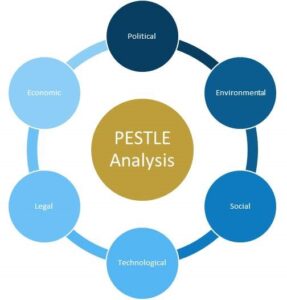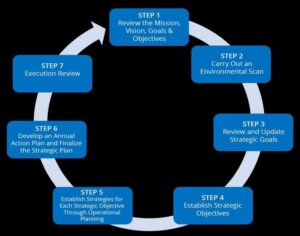Description of the module
The changes in the business environment require the HR professionals to engage in the understanding of the modern administration in the organisations.The module enables the learners to provide a review of the external business environment, with the aim of identifying the issues affecting the functioning of the organisation. In this perspective, the module provides some form of encouragement to the learners in developing solutions to the possible issues that affect the normal functioning of the organisations. Learners pursuing this module Business Issues and the Contexts of Human Resourceswill have to understand that the HR plays a bid role in all areas of the organisation. Therefore as HR professionals, they should be involved in planning to ensure that organisational strategies are well implemented
External factors impacting business and HR
The PESTLE analysis tool is recognised to help evaluate the external factors affecting businesses and the HR functions. PESTLE refers to the political elements, economic, social, technological, legal, and environmental issues.

Forces shaping the HR agenda
The HR professionals have a role to anticipate the changes likely to take place within organisations. Students taking this unit acquire the knowledge to be able to understand the strategies effective enhancing change, and in this perspective, they get to understand the strategies and activities that they have to get involved in (CIPD, 2015). The unit provides information regarding the changes in organisations, which affect HR functions such as recruitment, selection,employee rights, and other HR practices as well.
With the changes in the business environment, organisations seek to relate with the nature of competition, with which the HR professionals are expected to organise the different approaches to which they help the business achieve competitive advantage. The module in this perspective has developed the Ulrich model, which evaluates the nature of collaboration among the teams within the business platform (Ulrich, 1995). It is among the forces of HR that ensure that the agendas are met and business value is achieved.
Comparing business analysis tools
The main business analysis tools include SWOT (strengths, weaknesses, opportunities, and threats) analysis, PESTLE analysis, and the Porter’s Five Forces Model (Rivalry among competitors, Threat of new entrants, bargaining power of buyers, bargaining power of suppliers, and threat of substitute products). All these tools help the HR professionals gain insight on how to address the complexity of business issues, and in the process determine the nature of organisational success.In this unit, the learners get to learn about the differences in the identified tools, and how they are used to help analyse the external business environment, with the aim of determining the nature of organisational competitiveness. The tools will help organisations come up with different issues that need to be addressed, and a good example is the changes in the business environment as a result of the current coronavirus pandemic (Ritter and Pedersen, 2020).
Strategy formulation
Among the approaches that the unit relates with in the understanding of what strategy formulation is, they include the rational approach where senior managers take responsibility in monitoring the business environment both internally and externally. The emergent strategy approach relate with the emerging issues and the role of business management and HR in responding to the issues. Third is the symbolic approach where different approaches are considered in determining the success of business in the changing work environments.
Strategy exists in levels of corporate strategy, competitive strategy, and operational strategy, and the learners will have to relate with these to understand strategy formulation. Steps in strategy formulation are developed in the image below;

Business ethics and Accountability
The contributions of HR to business ethics in organisations help determine how well the organisations adapt to the ethical policies that govern their moral way of doing things. Accountability means that the HR in organisationshas to take into consideration how the business interacts with all stakeholders. Issues relates to the employee rights and values should be considered, learners taking this unit should be keen to facilitate and learn the most significant attributes associating to development of an ethical and accountable culture in the business.
Business planning
Examples of business planning tools include benchmarking, Lewin transitional model, value chain analysis, and use of balanced scorecard among others. These tools help evaluate the performance of the business in the changing environment context, and in the process help determine how well to enhance sustainability development.
The HR has a big role to play in measuring the tools of performance and business planning. This means that learners should work towards promoting their expertise, with the aim of ensuring that they effectively promote the business within the organisation in the best way possible. Adapting to change means that the HR has to be in constant communication with the business stakeholders to create awareness on the changing issues, and at the same time promote engagement of the employees (CIPD, 2015). In addition, promoting learning and development is a HR role that helps the professionals deal with the changes and relate to the significant issues that are considered to be part of the organisation planning process.
Business data
Getting to understand business issues requires the learners taking this course to understand the sources and uses of both business and HR data. The data may be external or internal to the organisation, but how the data is used determines the kinds of decisions taken by the HR to create an impact in the business planning, functioning, and overall performance. Thus in completing the course, information related to the use of different sources of data becomes significant in determining how successful the businesses are towards enhancing organisational success and development.
Learning outcomes
By the end of the unit, the leaders should;
- Be able to understand the external forces shaping the HR agendas, taking into consideration the important aspects of business strategies, insights, and solutions
- Have an understanding of the different analysis tools, including SWOT, PESTLE, and Porter’s five among others
- Understand the stages of business strategy formulation and implementation, and the role of HR in implementation of the identified stages
- Identify with the role of HR in business planning towards enhancing performance within the organisation
- Be able to respond to all changes experienced in businesses
Winding up;
This course is suitable for all individuals wishing to develop and grow their careers in HR management, as it provides information on the steps to be taken towards addressing issues of business and development. The learners after completing the unit will gain insights on the knowledge and skills needed in managing changes within the businesses. They will also have the knowledge to relate with the HR policies and practices that form part of the ethical culture in the organisation.
References:
CIPD, (2015) Changing HR operating models, Available at https://www.cipd.co.uk/Images/changing-operating-models_tcm18-10976.pdf
Ritter, T. and Pedersen, C.L., 2020Analysing the impact of the coronavirus crisis on business models,Industrial Marketing Management
Ulrich, D., 1995. Shared services: From vogue to value. People and Strategy, 18(3), p.12



